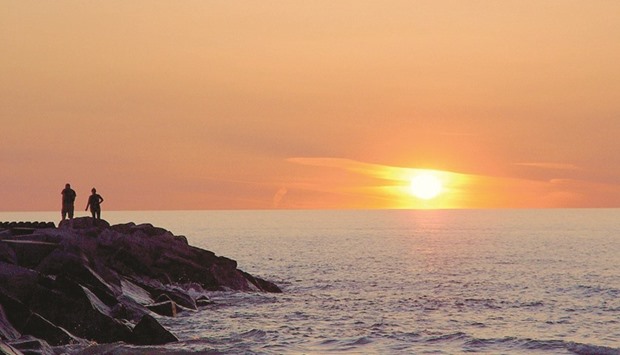Did you know that every time you have watched the sun set, you’re really seeing a mirage? I don’t mean to disappoint you, but I’m afraid it is true. On those romantic evenings, when you’ve been sitting on the beach, watching the sun sink below the horizon while the sky lights up in beautiful hues of orange and red, I’m afraid things haven’t quite been what they seem.
In reality, the sun has already set by the time it appears to us to be dropping out of sight. The sun actually disappears when it’s still about the width of the sun above the horizon. The only reason that we can see it after this is because light bends as it passes through the Earth’s atmosphere. This is just one of the strange properties of light, many of which often go unnoticed.
The setting sun is therefore a mirage, but when most people think of a mirage, they think of a weary traveller crossing a desert and seeing a sparkling lake in the distance. In cartoons, the traveller will usually be diving into the lake before it suddenly vanishes, but in reality the water would usually still be a long way in the distance before it melts into thin air. Cartoons have been known to depict the mirage as a lush oasis of palm trees and singing birds, but this would really be a hallucination rather than a mirage!
In Qatar, the hot, dry climate is perfect for forming this type of mirage. Almost every day it’s possible to see strange shimmering puddles of water on the road ahead of us. Of course, given the climate here, we know that they can’t really be puddles, but that’s not what our eyes tell us.
Mirages appear because light bends. We all know that it can bend, because when we put a straw in a glass of water, the straw looks bent, even though we know it isn’t. In a similar way, light also bends as it hits the Earth’s atmosphere, and this is why the position in which we see the sun isn’t where it actually is geometrically. This bending of light actually lengthens our daylight hours, by allowing us see the sun before it rises and after it sets.
The amount that the light bends depends on the temperature of the air, and this is why we see the strange puddles in the road ahead of us. Cold air is heavier and denser than warm air, so it bends the light more. In a hot country like Qatar, the sun bakes the ground far quicker than it can heat the air. That’s why the sand gets so hot on a sunny day, and can burn our feet. This means that during the day, when the sun is shining, the ground is hotter than the air. The air near the round also gets very warm.
With the air getting hotter closer to the ground, the light bends towards the cooler air, which is away from the ground. Therefore when we believe we are looking directly at the tarmac of the road ahead, we are actually seeing an image of the sky on the road, which looks rather like a puddle.
This is why the most common mirage is a patch of water on the road: it’s really just an image of the sky. It would be impossible to see a lake surrounded by swaying palm trees, like they show in cartoons.
Having said that, mirages can be rather more dramatic than a simple patch of water on the road. One April night in 1977, the residents of Grand Haven in the USA reported seeing a city with a flashing red beacon suddenly appear in the middle of Lake Michigan.
The nearest city in that direction is Milwaukee, which is approximately 128 kilometres (80 miles) away. The curvature of the Earth means that you would have to be in a building over a thousand metres high in order to see a distance of 128 kilometres. What the residents were seeing was therefore something of a mystery.
However, an ingenious resident timed the flashing of the beacon and rang a friend in Milwaukee. He discovered that the timing of the light coincided with the flashing of the light that was on Milwaukee harbour. It seemed physically impossible, but it really was the distant city of Milwaukee that the residents of Grand Haven were seeing.
Since 1977, the lights of Milwaukee have been spotted a number of times. However, it’s very rare and only happens on very calm conditions, usually between mid-April and mid-May. At this time of year, there is often very cold air high up in the atmosphere and the lights of the city actually bounce off the cold air to become visible to the distant city of Grand Haven.
Here in Doha, it’s unlikely that the lights of Dubai will suddenly appear across the waters of the Gulf, but we do see mirages almost every day. The hot sun has many weird and wonderful properties, and it’s something I’m reminded of every time I put a straw in my drink.

PICTURESQUE: The sun sets over Lake Michigan.
